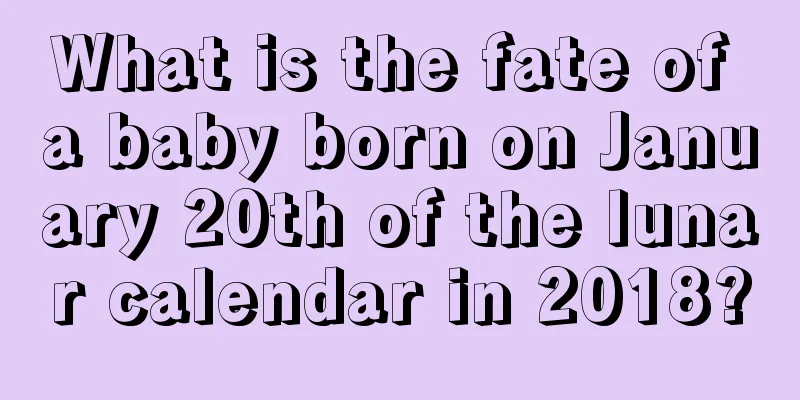When is the Beginning of Autumn in 2017? What are the customs?

Introduction: The Beginning of Autumn has arrived in the blink of an eye, and the arrival of the Beginning of Autumn heralds the beginning of autumn. So what is the date of the Beginning of Autumn in 2017? What are the customs? Let’s follow the editor to learn more about it. The leap sixth month of the lunar calendar in 2017 is approaching, and our lives are gradually entering a new mode. If you want to know more about the exciting content of the leap June 2017, please follow Mr. Shui Mo and read the relevant articles compiled for you!When is the Beginning of Autumn in 2017?Gregorian calendar: August 7, 2017 15:39:58 Monday Lunar calendar: The beginning of autumn on the 16th day of the sixth lunar month is the 13th solar term in the 24 solar terms of the lunar calendar and the first solar term of autumn, marking the official start of the Mengqiu season; "Autumn" means the end of summer and the beginning of coolness. When the Beginning of Autumn comes, the paulownia trees start to shed their leaves, hence the idiom “falling leaves indicate the coming of autumn”. From a literary perspective, the word "autumn" is composed of the characters "禾" and "火", which means the maturity of crops. Autumn is a transitional season when the weather changes from hot to cool, and then from cool to cold.Beginning of Autumn, July Festival. The meaning of the word "Li" is spring. Autumn means gathering, and things are gathered here. The first sign is the arrival of a cool breeze [according to The Book of Rites, it is written as the arrival of a blind wind]. The bleak wind from the west is called the cool breeze. When the temperature changes, the cool air begins to set in. "Zhou Yu" says that when fire appears, the wind will cool and the cold will be avoided. The second sign is the arrival of White Dew. After the heavy rain, a cool breeze comes, and the sky is white and the sky is falling, but it has not yet condensed into beads, so it is called the White Dew, indicating the white color of autumn gold. What are the customs of the Beginning of Autumn?1. Beginning of Autumn Festival Beginning of Autumn Festival, also known as July Festival. The time starts on August 7 or 8 of the Gregorian calendar every year. In the Zhou Dynasty, on this day, the emperor personally led the three dukes, six ministers, princes and officials to the western suburbs to welcome the autumn and hold a ceremony to worship Shaohao and Rushu (see "Rites and Sacrifices. Monthly Ordinances"). This custom was still followed in the Han Dynasty. "Book of the Later Han". "Records of Sacrifices" reads: "On the day of the Beginning of Autumn, people welcome autumn in the western suburbs and offer sacrifices to the White Emperor. The chariots, flags and clothes are all white, and people sing "Xi Hao" and perform the Eight-Legged Dance of "Yu Ming". The emperor also goes into the garden to shoot animals as a sacrifice to the ancestral temple, a ceremony called "Qiu Liu". Killing animals as sacrifices means to show the power of military force when autumn comes." In the Tang Dynasty, people also offered sacrifices to the Five Emperors on the day of the Beginning of Autumn. "New Book of Tang Dynasty" "Book of Rites and Music" reads: "At the beginning of autumn and the beginning of winter, sacrifices are made to the Five Emperors in the four suburbs." In the Song Dynasty, on the day of the beginning of autumn, both men and women wore catalpa leaves to follow the order of the season. There is a custom of cutting red heather leaves into petals and wearing them in the hairpins, and there is also a custom of swallowing seven small red beans with autumn water (see "Lin'an Sui Shi Ji"), which is a Ming custom inherited from the Song Dynasty. In the Qing Dynasty, people would hang a scale to weigh themselves on the day of the Beginning of Autumn and compare the result with that on the Beginning of Summer to determine whether they were fat or thin during the summer. Since the Republic of China, there has been a custom in many rural areas to predict whether the weather will be cold or hot during the day or night of the Beginning of Autumn. There is also the custom of eating watermelon and green beans to taste new things and pay tribute to ancestors. There is also a custom of eating frozen melon, steaming preserved eggplant, and frying Cymbopogon citratus to drink on the day before the beginning of autumn. 2. The 15th day of the eighth month in the lunar calendar is the Mid-Autumn Festival. On this night, married women who have not yet given birth, accompanied by their younger sisters-in-law or other female companions, go to the melon and bean sheds in the fields and secretly grope for the melons and beans, hence the name "Mo Qiu". It is said that touching a pumpkin will easily lead to the birth of a boy, and touching lentils will easily lead to the birth of a girl. Touching white lentils is even more auspicious, as it is a good omen for the birth of a girl and a long life together. According to traditional customs, anyone can pick melons and beans at night, and the owner of the farm is not allowed to blame them. No matter how late the aunt and sister-in-law return home, the parents are not allowed to blame them. This custom existed before the Qing Dynasty and has been popular among the people since the Republic of China. For example, in the Zhulin Pass area of Shangluo, on the night of the Mid-Autumn Festival, before the moon comes out, children would go into the nearby autumn fields as usual and take something home. If the child touches onions, the parents believe that the child will be very smart when he grows up; if the child touches fruits, the parents believe that the child will have no worries about food and drink and everything will go well in the future. People regard "touching the autumn" as a game and do not treat it as theft. After this day, parents are required to restrain their children and not to take even a branch or leaf from other people's melon fields. On the night of the Mid-Autumn Festival, after eating moon cakes, residents of Shangnan County have children who refuse to grow taller touch sorghum; families without boys touch eggplants; families without girls touch chili peppers; and families with stupid children touch onions. 3. Autumn Busy Season Fair The Autumn Busy Season Fair is usually held in July or August of the lunar calendar. It is a business and trade conference to prepare for the Autumn Busy Season. Some are held in conjunction with temple fairs, while others are trade fairs held solely for the busy autumn season. The purpose was to exchange production tools, sell livestock, exchange food and daily necessities, etc. Its scale is similar to that of the summer busy fair, with a mule and horse market, a grain market, a farm tool production market, cloth, and a Beijing-Guangzhou grocery market. Nowadays, such gatherings are called "Economic and Trade Exchange Conferences." During the festival, there will be drama performances, horse racing, monkey shows and other cultural programs to liven up the party. 4. Mutual assistance in autumn harvest When the busy autumn season begins, there is a common custom of "mutual assistance in autumn harvest" in rural areas. You help me and I help you, and groups of three or five go to the fields to harvest the ripe corn. A crop of corn needs to be moved four times: the first crop, the second crop, the third crop, and the empty crop. Women, old people, and children in their teens carried bamboo baskets and moved the plants one by one, row by row and plant by plant. Be careful not to do as "a monkey carries corns, carrying one and leaving one behind." Instead, carry one and put it in a cage, then place it in the pile of corn cobs at the edge of the field, and finally pull it home on a cart. In the first batch, the mature corn ears are moved first, and the immature corn ears are left for the second batch. The second and third crops are moved using the same method. Finally, the remaining corn cobs, regardless of age, are cleared out and brought home. We’ll see which family’s corn matures first and move it to that family first. This way we don’t violate the farming season and still get enough grain to store in the warehouse. 5. Akita Entertainment In autumn, especially before and after the busy autumn season, farmers are busy with autumn planting and harvesting, and everyone is having a lot of fun! But there is also fun in the busyness. It is common to see young people and children over ten years old playing and performing in the fields after the corn, millet and broomcorn have grown, especially when the corn has grown to a height of one meter and has begun to form ears. They moved the young corn ears down, dug a hole in the ground, and left a chimney, which became a natural earthen stove. Then they put the young corn ears in the stove, picked up firewood everywhere, and the corn tops were good fuel, so they added fire to burn them. Soon all the corn ears in the kiln were cooked, and a rich corn banquet was held in the fields. They also climbed trees to catch sparrow eggs and hunted rabbits on the spot. There were a lot of edible game, all of which could be cooked in pots in the wild. There are both meat and vegetarian dishes, with all kinds of flavors. They also put the persimmons and sweet potatoes they picked in earthen caves and warm them for an hour, and they will turn into sweet persimmons. This kind of fun in Akita has been passed down from generation to generation. 6. Putting on weight in autumn: It is popular among the people to weigh people on the day of the Beginning of Autumn and compare their weight with that at the Beginning of Summer. Because people don’t have much appetite in the summer, and their meals are light and simple. After two or three months, most of the weight will be reduced. With the arrival of autumn wind, appetite opens up. People want to eat something delicious to increase nutrition and make up for the loss in summer. The way to make up for it is to "put on weight in autumn": on the day of the Beginning of Autumn, eat all kinds of meat, stewed meat, grilled meat, braised meat, etc., "put on weight with meat". 7. Gnawing Autumn "Gnawing Autumn" is also called "Biting Autumn" in some places. People in Tianjin pay attention to eating watermelon or cantaloupe on the day of the Beginning of Autumn, which is called "biting the autumn". It means that the scorching summer heat is unbearable, so when the Beginning of Autumn comes, people will bite it. Jiangsu and other places also eat watermelon on the day of the Beginning of Autumn to "bite autumn", which is said to prevent autumn prickly heat. In Zhejiang and other places, people eat watermelon and liquor together on the Beginning of Autumn, which is believed to prevent malaria. People in the city buy a watermelon on the day of the Beginning of Autumn and take it home. The whole family gathers together to eat it, which is called the Beginning of Autumn. Farmers, on the other hand, are much more unrestrained in their autumn harvest. They sat on the ground in groups of three or five in the melon shed and under the shade of the trees, munching on red-fleshed watermelons, green-fleshed cantaloupes, white sweet potatoes, and golden corn cobs. What one expresses while chewing autumn fruits is actually the joy of harvest. 8. Autumn Festival Autumn Festival was originally a day for worshiping the land god in autumn. It began in the Han Dynasty. Later generations set the Autumn Festival on the fifth day after the beginning of autumn. By this time the harvest was complete, and both the government and the people offered sacrifices to the gods and expressed their gratitude on this day. In the Song Dynasty, there was a custom of eating cakes, drinking wine, and women returning to their parents' homes during the Autumn Festival. The poem "Not Seen" by Han Wei of the Tang Dynasty reads: "I wish to be a swallow in your house, and I will not return even when the Autumn Festival comes." In some places, the sayings of "building a community", "worshiping the community gods" and "cooking community porridge" are still popular today.Summary: Through the above article, we know the date of the Beginning of Autumn in 2017 and the customs. I hope it can help everyone! |
Recommend
Can I register for a marriage certificate on Grain Rain Day in 2020? What do I need to prepare for marriage registration?
Can I register for a marriage certificate on Grain...
Is it possible to break ground on October 11, 2019? What are the auspicious days for breaking ground?
Most of the houses in rural areas are self-built, ...
Is the Cold Clothes Festival on the first day of the tenth lunar month in the Year of the Rat 2020 a suitable day for funerals?
Is the Cold Clothes Festival on the first day of t...
When is the Frost Descent solar term in 2019? What are the solar terms in autumn?
Frost Descent is the eighteenth solar term of the ...
Which days in the sixth lunar month of 2018 are suitable for travel? What are the essential items for traveling?
Introduction: Everyone hopes to encounter good thi...
Is it appropriate to pray for a child during the Beginning of Autumn in 2019? Is there a high hope of achieving success on this day?
Every season I hope to have children around and ha...
Is it okay to go to the temple to pray on June 22, 2020, the Year of the Rat?
Is it okay to go to the temple to pray on June 22,...
Where is the direction of the God of Happiness on the 14th day of the second lunar month in 2017?
Introduction: The God of Happiness is the god who ...
Will the career luck of those born in the Year of the Ox be good when they go back to work after the holidays? good luck?
Introduction: Career luck is very important for ev...
Is it possible to propose marriage on April 12 of the lunar calendar in 2022? Is it an auspicious day to propose marriage?
Proposing a marriage is a very important matter, a...
Is July 22, 2022 a good day in the lunar calendar?
Is July 22, 2022 a good day in the lunar calendar?...
Where are the 12 lucky gods in the first month of 2018?
1. What day is the twelfth day of the first lunar...
When is the third Geng day after the summer solstice in 2019? What does it mean to count the first day of the third Geng day after the summer solstice?
I have heard the saying "The third Geng day a...
Poems about Xiaoxue, an inventory of ancient poems related to Xiaoxue solar term
The first snow in Taihang Mountain brought with it...
There are three signs in the Autumnal Equinox. What are they?
It takes more than a month from the Beginning of A...









